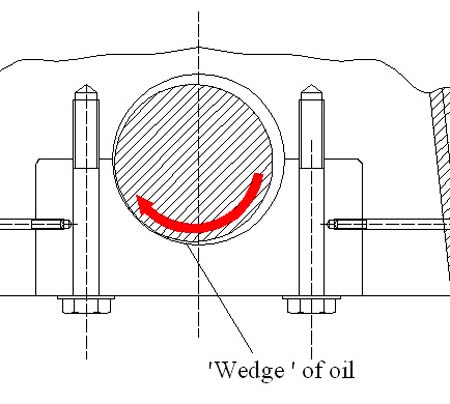Bearing lubrication
The total friction in an engine is the sum of that emanating from a number of different sources operating at a range of widely varying conditions. Temperature, load, surface condition and shear rate are all implicated in this total amount of friction generated, and depending on how these parameters relate, a particular set of components will produce more or less of it. The engine lubricant, of course, is primarily intended to reduce this friction and hence the wear in a component and depending on the regime prevailing at the time - be it boundary, mixed, hydrodynamic or even elastohydrodynamic (EHD) - the component parts of the oil work either independently or together to minimise it. Although not the major source of friction in an engine, simply because there are lots of them and they are heavily loaded, the bearings often have a major influence on the type of lubricant used.
Copper-lead or perhaps aluminium-tin, with or without an overlayer, a plain journal bearing will never be able to function as desired without lubrication. Forced between two surfaces (the bearing and its journal) by the action of the oil pump, this oil together with the rotating action of the journal creates a 'wedge' of the stuff that keeps the surfaces apart, hence reducing the friction between them. If the pressure in this wedge is sufficient and the asperities of the journal and those of the bearing surface no longer interlock, the bearing is said to operate in the hydrodynamic regime. If these asperities interlock though, even if ever so slightly, friction (and hence wear) will be generated and the lubrication regime will become mixed or in the worst case boundary.
Of the many components comprising a modern engine lubricant, only the viscosity and the friction modifiers, if included, can directly affect the friction generated. Altering the shear rate within the bearing assembly by increasing the clearance can reduce friction, but the extra clearance will need higher oil 'make up' or flow, and so any performance released by reducing the friction may be consumed again by the extra lubricant to be pumped. On the other hand, too fine a clearance will never allow the oil to flow, and the heat generated - which is otherwise taken away with the oil as it leaks away - will inevitably lead to bearing failure.
Once the engine has fired and the journal is rotating, the main effect of the lubricant is attributed to the viscosity of the fluid at the prevailing temperature and the induced shear rate of the fluid. As this rate of shearing increases, the viscosity modifiers in the oil (which are designed to control the oil's viscosity with temperature) will lose their effectiveness and the oil will shear down to the viscosity of the base fluid. In a bearing therefore, one of the critical parameters is that of its viscosity at high speed and high shear rate, and is often referred to as HTHS. However, a lower HTHS viscosity lubricant would most likely produce a lower minimum oil thickness, which is so critical to the durability of the bearing. Under these conditions the presence of the friction modifier would come into play, for not having a major influence under hydrodynamic (or EHD) conditions, as the film thickness reduces, its presence could help reduce the friction by another way.
The selection of the lubricating oil for high-performance engines is a little more complex than most think.

Fig. 1 - A typical engine bearing
Written by John Coxon